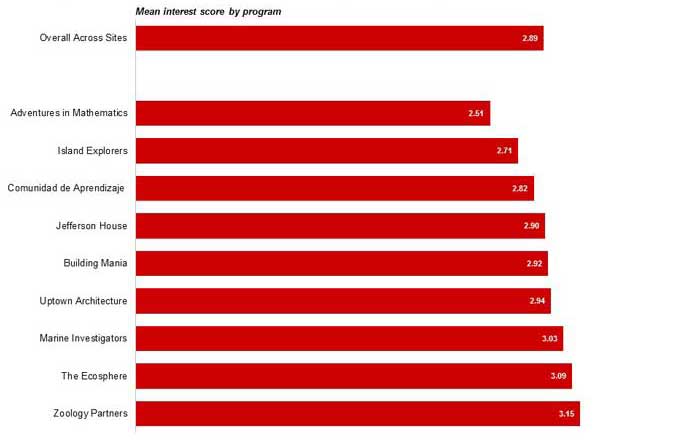STEM IE Research Findings
We used the Experience Sampling Method (ESM) to have youth report their in-the-moment perceptions of interest, which allowed us to measure their situational interest. Their level of individual interest and their aspirations for pursuing STEM in the future were measured using surveys given before and after the program.
Figure 1. Program interest scores were generally higher in programs with both classroom and field components.
This may be related to the manner in which these programs integrated classroom and field experiences, with scores highest in programs that involved a field-based component related to studying the local ecology and species contained in that environment. Adventures in Mathematics, a program that focused primarily on the development of basic math skills, had the lowest overall score (based on a 1 to 4 scale).

Program Experiences and Situational Interest
We found that youth experienced more situational interest when they were doing tasks that they perceived as challenging and relevant, regardless of their level of individual STEM interest when they began the program. In addition, the type of activity they were doing (e.g., lab, creating products) in and of itself did not consistently predict their situational interest. In this sense, making sure that activities are both challenging and relevant for youth are important characteristics of any type of STEM-oriented activity.
Program Experiences and Growth in Youth Interest
In addition, several cumulative experiences youth had while participating in the STEM IE program were found to be related to growth in youth interest in STEM when comparing pre- and post-survey results.
- Although doing a lab and creating products were unrelated to youths’ level of triggered situational interest at any given moment, youth who spent more total time doing these two activities in their summer program reported increased individual STEM interest from pre- to post-survey.
- Youth who reported feeling a higher sense of agency during program activities showed significant increases in individual interest in STEM over the course of the program.
- When youth experienced sustained momentary engagement in the specific tasks they did in summer STEM programs, they showed significant increases in individual STEM interest from pre- to post-survey.
Youth who experienced more agency while participating in STEM activities also developed stronger STEM career aspirations over the course of the program, demonstrating a fairly profound shift in interest and commitment.